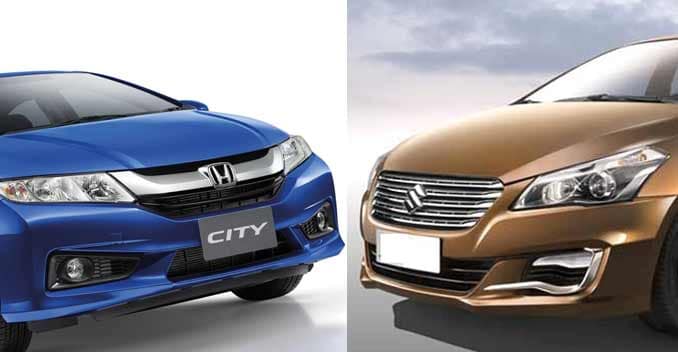
The City is a success story, the car has been the segment leader ever since it rolled out in India 16 years ago. The current fourth generation model also offers diesel power, making it the best selling car in the segment by a huge margin. Look at the number of new Citys on the roads today and you will agree. But what about the competition? Maruti Suzuki have always tried to challenge Honda by introducing a more affordable sedan but the last two attempts never really worked for them. In fact Hyundai has been a bigger threat to Honda, the Verna being the nemesis. Maruti may have been busy introducing a new hatchback every year but it seems they have not given up on the C-segment. While the new City and Verna rolled out, the nation’s largest carmaker went back to the drawing board and are now back with the Ciaz. Welcome then to the most important test of the year.
Design and Styling:All three cars here are distinctive, good looking sedans. The Verna is the oldest of the lot but the fluidic design has been one of the main reasons for the car’s success. Over time, there have been certain additions, like the attractive daytime-running lamps and unique diamond cut alloy wheels. But the overall silhouette has remained the same, the fast flowing lines and coupe-ish sloping roof are unique for a car in this segment and a contrast to the City and Ciaz that follow a more edgy approach. The previous Citys followed a simple three-box design, but the new generation model is a lot more angular and features a prominent shoulder line, look at the car from any angle and you know it’s a busy design.
The Ciaz in comparison is the newest car here but doesn’t look like one. It’s a hard decision to make when carmakers style their cars – design them too bland and nobody is interested, make it too loud and some tend to avoid the model. Maruti has tried to play the safe game with the Ciaz. It does follow the same design theme as the concept that was shown at the Auto Expo but is a lot more toned down, a smart design but not the most attractive here. The face is very different when compared to its Maruti siblings but the front grille gives the car a typical Suzuki look. The sides are flat and not in sync with the front and rear ends, the tail lamp design is very similar to the City but look at both cars in the flesh and you will be able to differentiate between the two.
Interior:Step inside the Verna and unlike the exterior, the cabin isn’t very appealing but the quality of materials used is still on par with the rest. The darker shade of beige is not as elegant as the Ciaz or the City while the centre console and the basic small display stereo looks out of place. The City meanwhile follows a modern approach, the layout is clean while the piano black and silver inserts give the cabin a premium look. Even the AC controls are very different, it’s a touch panel and is easy to use. The Ciaz interior fits between the Maruti and Honda. It is neither too bland nor too loud, it is more like an evolved Swift interior and even borrows a few switches and parts, which isn’t a bad thing but Maruti could have used newer ones, considering the Ciaz is a more premium car. The steering wheel for instance is the same as in the Swift/Dzire but features some chrome detailing and Bluetooth telephony controls, it is good to grip though.
Engine and performance:The diesel engines in these cars are all different capacities, the Ciaz uses a 1.3-litre engine, the City a 1.5l and the Verna, features a larger 1.6l unit. Max power and torque are as expected, the Verna tops the list followed by the City and then the Ciaz. The Hyundai oil burner is also the most refined engine, it feels almost petrol like and it’s disappointing that neither the Honda nor the Maruti come even close. But great power needs great boost too – the Verna displays the most turbo lag, so driving in bumper to bumper traffic is not as effortless as in the City and or the Ciaz. The latter uses the same engine that was used in its predecessor, the SX4 but finetuned for better driveability. There is hardly any lag and one can drive at slower speeds even in a higher gear.
Feature:It was the Hyundai Verna that first introduced a long list of comfort and safety features to this segment. Today, thanks to the Korean carmaker, both the City and the Ciaz now offer an even longer list. While the top-end City offers a sunroof, the Ciaz offers a touchscreen infotainment system that also features navigation. All cars, in their top end trims, offer keyless ignition and entry and a reverse camera function, but the Honda display is larger and offers different zoom levels too. The Maruti is the only car that gets a rear sunshade and reading lamps while rear AC vents are standard both in the Ciaz and the City. In terms of safety, even the base City and Verna diesels offer standard ABS and a driver airbag, while the equivalent Ciaz makes do without them. The top end Verna, in addition, also offers side airbags. The Hyundai and Maruti top variants use projector lighting but the Honda sticks to conventional halogen bulbs. It’s a close fight in terms of features, every car offering something unique.
No comments:
Post a Comment